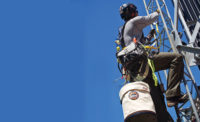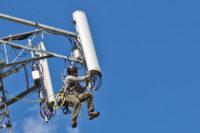Secure your tools when working at heights

Reality check
According to the Bureau of Labor Statistics, in 2010, there were 263 fatalities from being struck by a falling object or equipment in the U.S., which accounted for 6 percent of all workplace fatalities. Dropped objects are a serious concern that can put a workforce at risk and result in lost productivity.
Other negative results of dropped objects include the cost of damaged equipment, whether it is the dropped object itself or an object it impacts below.
But even if no damage or injury occurs from a dropped tool, a worker can lose hours of productivity by retrieving a mission critical tool, wasting time and money for the company.
Objects at heights risks
Objects at heights safety involves the following key risks:
1) Untethered, unorganized objects at an aerial jobsite.
When tools and gear are kept in unorganized, uncovered or un-closeable containers or, conversely, not kept in containers at all, there is a much higher likelihood of these objects falling at heights.
There is also a need for special attention to cords, ropes and hoses that may line and/or cross walkways. All of these situations create a heightened risk of worker trips and falls caused by loose items and movement from scurrying around to locate them.
2) Improper transport of objects to and from an aerial jobsite.
Another serious concern is the hoisting of equipment to and from the elevated jobsite. When climbing, a worker must maintain three points of contact to the ladder or structure.* Carrying a bag of tools up in one hand makes it difficult for a worker to abide by this important safety precaution. Buckets are a common solution; however, without a top, all it takes is one gust of wind to turn that bucket on its head — literally.
What do the standards say?
Though regulations and other developing workplace standards can sometimes be unclear, there are numerous mentions of tools and equipment in aerial safety. In reference to worksite organization, OSHA states in their General Industry Standard:
1. “Tools, materials and debris not related to the work in progress shall not be allowed to accumulate on platforms.”
In reference to falling objects, OSHA states in their Construction Standard:
2. “All materials, equipment and tools, which are not in use while aloft, shall be secured against accidental displacement.”
OSHA also continues in the Scaffolding Standard Section to discuss more about prevention of falling objects. OSHA sums everything up in the OSHA Construction E-Tool: “workers secure tools and materials to prevent them from falling on people below.”
Across the pond
The United Kingdom’s Health and Safety Executive (HSE) refers more specifically to falling objects in their Work at Height Regulations 2005 (Regulations 10 & 11: 39 - 42):
1. “Where it is necessary to prevent injury, you must do all that is reasonably practicable to prevent anything from falling.”
2. You must ensure that nothing is:
a. Thrown or tipped from height if it is likely to injure anyone;
b. Stored in such a way that its movement is likely to injure anyone.”
Additionally, the UK organization known as DROPS (The Dropped Objects Prevention Scheme) is gaining global traction and becoming a source for best practices across the oil and gas industry.
Their work starts with educating companies and workers on the costs of a dropped object — from monetary, to productivity, to death — and then providing recommended rules and solutions to reduce/eliminate risk. While they specifically address the oil and gas industry, the education and solutions provided by DROPS are beneficial and can be applied at any aerial jobsite.
Objects at heights solutions
The first step is to identify the specific challenges for the job at hand and formulate a plan. The next step is to identify solutions to help workers stay safe and be more productive. Critical solutions include:
1),Safely organizing and tethering all objects at an aerial jobsite.
Using organizers to keep cords, hoses and ropes tied up prevents them from becoming trip hazards. Efforts made to tie tools off on a lanyard or tethering device will pay for themselves in eliminating damage to equipment, reducing lost productivity and most critically preventing injury or death.
2) Safe and proper storage and transport of objects to and from an aerial jobsite.
To minimize risk for items falling out, your choice should always be a container or pouch with a cover or closure.
Another important decision is whether to carry or hoist the container. If carrying, be sure the container allows the worker to maintain three points of contact. If this proves difficult, look for a container with versatile handles or belt/body attachment methods to free hands up. If the weight of the gear is too heavy for a worker to carry on his or her own, the decision should be to hoist the equipment.
Finally, make sure to look for a weight rating on the product. A proper safety solution should have a stated weight rating and a safety factor built into the product for added confidence.
Organize & secure equipment
Think inside the bucket — and keep it organized up there!
Aerial Height Safety goes beyond your standard fall protection. Once a legitimate plan is in place to ensure workers are safely tied off, the next step is to ensure the equipment going up alongside the worker is just as secure. Identifying and preparing solutions for these challenges is mission critical to completing a full circle safety at heights plan.
References
A. **BLS: National Census of Fatal Occupational Injuries in 2010, Page 7; August 25th, 2011
a. section on Powered Platforms, Manlifts, and Vehicle-Mounted Work Platforms (29CFR 1910, Subpart F)
b. under the subpart on steel erection (29CFR 1926.759(a)
c. 1926.451(h) (falling object protection)
Looking for a reprint of this article?
From high-res PDFs to custom plaques, order your copy today!





